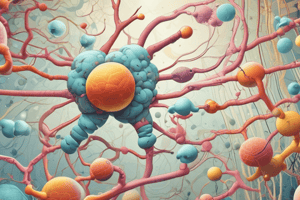Podcast
Questions and Answers
What does deamination metabolize?
What does deamination metabolize?
Proteins
Where does deamination occur?
Where does deamination occur?
Mitochondria
What is deamination?
What is deamination?
The enzymatic removal of an amine group (NH2) from an amino acid.
What does deamination produce?
What does deamination produce?
What is a protein?
What is a protein?
What is the first step of deamination?
What is the first step of deamination?
What is the pH of your stomach?
What is the pH of your stomach?
Can your stomach break down proteins?
Can your stomach break down proteins?
Why aren't enzymes located in the stomach?
Why aren't enzymes located in the stomach?
How do you digest proteins?
How do you digest proteins?
What proteases do your stomach secrete?
What proteases do your stomach secrete?
What do proteases do?
What do proteases do?
What was the experimental setup to determine what pH each protease functioned best in?
What was the experimental setup to determine what pH each protease functioned best in?
What pH does pepsin function best at?
What pH does pepsin function best at?
What pH does trypsin function best at?
What pH does trypsin function best at?
What pH does chymotrypsin function best at?
What pH does chymotrypsin function best at?
Where is pepsin located?
Where is pepsin located?
Where are trypsin and chymotrypsin located?
Where are trypsin and chymotrypsin located?
What happened when pepsin was incubated with three different protein substrates, and its degradation was monitored over 4 hours?
What happened when pepsin was incubated with three different protein substrates, and its degradation was monitored over 4 hours?
What happens once the proteases have broken down the protein into amino acids?
What happens once the proteases have broken down the protein into amino acids?
What is significant about an R-group?
What is significant about an R-group?
What does the accumulation of GDP mean?
What does the accumulation of GDP mean?
What happens when GDP accumulates?
What happens when GDP accumulates?
What would happen if all amino acids were deaminated upon arrival to the mitochondria?
What would happen if all amino acids were deaminated upon arrival to the mitochondria?
Proteins can be ____
Proteins can be ____
What is GDH?
What is GDH?
What four molecules allosterically modulate GDH?
What four molecules allosterically modulate GDH?
What inhibits deamination by GDH?
What inhibits deamination by GDH?
What does GDH consume?
What does GDH consume?
What does GDH produce?
What does GDH produce?
What is the most important part of deamination?
What is the most important part of deamination?
What would happen without the regulation of GDH and other deaminating enzymes?
What would happen without the regulation of GDH and other deaminating enzymes?
What is water's role in deamination?
What is water's role in deamination?
What happens to ammonia?
What happens to ammonia?
What is dangerous about high levels of ammonia?
What is dangerous about high levels of ammonia?
How much nitrogenous waste does each urea carry?
How much nitrogenous waste does each urea carry?
Formation of NADH from water and NAD+ = +/- Delta G?
Formation of NADH from water and NAD+ = +/- Delta G?
Flashcards are hidden until you start studying
Study Notes
Deamination Overview
- Deamination metabolizes proteins, specifically by removing an amine group (NH2) from amino acids.
- Occurs primarily in the mitochondria, where enzymatic activity leads to energy production.
Proteins and Digestion
- Proteins consist of amino acids linked by peptide bonds, forming polypeptides.
- The stomach has a highly acidic pH of 1 or 2, aiding the breakdown of proteins via proteases.
- Pepsin, trypsin, and chymotrypsin are key proteases secreted for protein digestion.
Protease Functionality
- Pepsin operates best at pH 2, while trypsin functions optimally at pH 8, and chymotrypsin operates well at pH 10.
- Each protease can act on different substrates; for example, hemoglobin is easily digested, whereas ovalbumin is not.
Role of GDH in Deamination
- GDH (Glutamate Dehydrogenase) plays a critical role in deamination, converting amino acids into energy.
- It is allosterically activated by GDP accumulation, indicating low energy levels.
- GDH consumes one amino acid and one NAD+, producing ammonia, NADH, and an oxidized amino acid.
Regulation of Deamination
- Regulation of GDH is crucial to avoid the complete deamination of amino acids, which can be fatal due to the loss of proteins coded by mitochondrial DNA.
- High-energy molecules like ATP and GTP inhibit GDH activity, preventing excessive deamination.
Ammonia Handling
- The amine group (NH2) is converted to ammonia (NH3), which is subsequently transformed into urea for excretion via the kidneys.
- Elevated ammonia levels can be harmful, potentially damaging kidney function.
Nitrogenous Waste
- Each urea molecule carries the nitrogenous waste equivalent to two deaminated amino acids, represented as NH2-CO-NH2.
- The formation of NADH from water and NAD+ results in a large positive delta G of +220 kJ/mole, indicating an energy-consuming process.
Conclusion
- Successful protein metabolism through deamination leads to energy production while maintaining homeostasis and minimizing toxic byproducts.
Studying That Suits You
Use AI to generate personalized quizzes and flashcards to suit your learning preferences.




